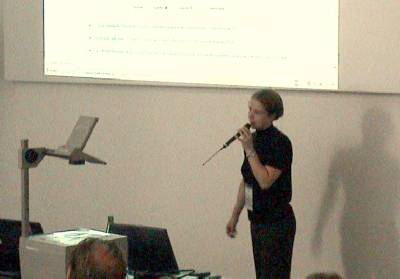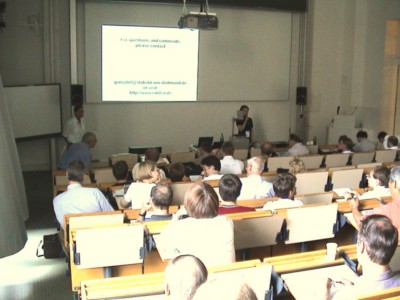We will illustrate the design of the written content of a new interactive software for statistical education, called EMILeA-stat (currently under development). Through our work, we suggest a way of teaching statistical theory/methodology via an internet-based, multimedial environment. To foster a greater understanding and appreciation of statistics among students, EMILeA-stat aims at achieving and maintaining a maximum level of student activity.
In this talk, we choose the nonparametric Wilcoxon Rank Sum Test to demonstrate the structure and didactic features embodied by EMILeA-stat. The assumed level of instruction, called level B here, is a medium level of difficulty, to address college students not majoring in Statistics. For completeness reasons we mention that level A intends to illustrate the basic ideas, where as level C is written for mathematically orientated, more advanced students.
There have been initiatives to reform college level statistical education in the United States. In particular, the ASA has recommended that introductory statistics courses rely more on computers and automated computations (Cobb, 1992). Moore (1997) has advocated a constructive model of learning, in which students are encouraged to learn through their own activities and teachers are to de-emphasise lecture-based classroom teaching. Velleman and Moore (1996) stress that multimedial instruction can be highly interactive and provide immediate feedback, while allowing students to determine their own pace of learning.
When introducing statistics to students (especially non-majors in the subject), teachers often lament of encounters with student apathy and resentment toward statistics. Many students experience "math anxiety" or "symbol shock" (described by Tanur, 1997), often as a result of discouraging past coursework in mathematics/statistics. Success in teaching statistics requires an educator to create a level of greater accessibility and relevance in their instruction; a tenant of often overlooked "humanistic" educational psychology is that students learn best what they want and need to know (Gage and Berliner, 1991). This educational environment can be realized with EMILeA-stat. Within each presented statistical procedure, we value and attempt to incorporate "real-world" problem scenarios and data to make statistical tools more appealing to students. We design the presentation of the educational material (eg. the Wilcoxon Rank Sum Test) to allow and encourage individual student activity in learning statistics (intended for use both in and outside the classroom).
The format, which we suggest, enables students to explore material at their own pace and allows for a two-way flow of information (eg. intervative applet or multiple choice questions). Hence, the student users can actively process information and construct meaning for the statistical method, which is better for memory retention as well (Rumelhart and McClelland, 1986, connectionic learning model). An advantage of the multimedial environment is the capacity to provide significantly more examples than are possible in a classroom setting, where time is a practical constraint. This increases the opportunities for student exposure to statistical applications.
In our internet-based teaching approach, presented material is intended and formulated to be as concise as possible. The internet provides the possibility to illustrate statistical methods, without requiring students to search through and read numerous text book pages. At level B, introduced statistical procedures are intended to give students a basic working knowledge of the statistical methodology, enabling the students to apply what they learn and to use formulas. Once an understanding of application is established for a statistical method, the student/teacher is given the possibility to explore the theoretical justification for the method at level C.
We propose an interactive Java applet to enhance student understanding of the Wilcoxon Rank Sum Test and give further suggestions on effectively structuring multimedial material for students.
We wish to emphasise that EMILeA-stat (though written to be a self-contained, interactive learning tool) is intended to supplement, not replace, a classroom instructor. A high level of communication between an instructor and students, allowing for the immediate exchange of ideas, is in our opinion indispensable for success in statistics eduation (cf. Moore, 1997).
Cobb, G. (1993). Teaching statistics. In Heeding the Calls for Change: Suggestions for
Curricular Action, Ed. L. A. Steen, pp. 3-43. Washington, D.C.: Mathematical Association
of America.
Moore, David S. (1997) New Pedagogy and New Content: The Case of Statistics,
International Statistical Review 65, 2, 123-137.
Rumelhart, D., & Mc Clelland, J. (Eds.). (1986). Parallel distributed processing: Explorations
in the microstructure of cognition. Cambridge, MA: MIT Press.
Tanur, Judith M. (1997). Discussion : Leading Horses to Water, International Statistical
Review 65, 2, 159-161.
Key words:
Statistical education, multimedia, internet-based learning environments, pedagogy, EMILeA-stat

